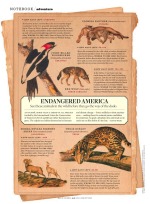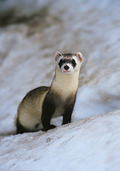 From the Red Wolf to the Sierra Nevada Bighorn.5 cool species almost gone, >400 words, Men's Journal, July/August, on stands now (with Lance Armstrong on the cover--yet again!).
From the Red Wolf to the Sierra Nevada Bighorn.5 cool species almost gone, >400 words, Men's Journal, July/August, on stands now (with Lance Armstrong on the cover--yet again!).
nb. $50,000 for credible proof on an Ivory Bill...
Plus, here's one that didn't make the cut...
Black-footed Ferret (Mustela nigripes)
HOW MANY LEFT: <250 born in the wild
Once a common scourge of prairie dogs across the Great Plains, this sleek, mostly nocturnal predator (the only ferret native to North America) was by the 1970s believed to be extinct. The discovery of a remnant population in Wyoming in 1981 led to the capture of the last 18 survivors, a breeding program, and subsequent re-introduction into the wild. They are considered self-sustaining in small populations at only three locations.
 Natl Geographic PhotoWHERE TO SEE ONE: “Prairie dogs don’t become active until about a half hour after sunrise so the window to pick out a ferret is slim,” says Travis Livieri, of Prairie Wildlife Research. Try Wind Cave National Park in South Dakota, where on summer nights rangers offer guided visits to prairie dog colonies along the road.
Natl Geographic PhotoWHERE TO SEE ONE: “Prairie dogs don’t become active until about a half hour after sunrise so the window to pick out a ferret is slim,” says Travis Livieri, of Prairie Wildlife Research. Try Wind Cave National Park in South Dakota, where on summer nights rangers offer guided visits to prairie dog colonies along the road.
 SG
SG
